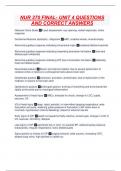NUR 370 FINAL- UNIT 4 QUESTIONS
AND CORRECT ANSWERS
Glascow Coma Scale ✅3 part assessment- eye opening, verbal responses, motor
response
Duchenne Muscular dystrophy - diagnosis ✅H&P, creatine kinase, muscle biopsy
Abnormal pupillary response indicating intracranial mass ✅unilateral dilation/reactivity
Abnormal pupillary response indicating impending brainstem herniation ✅fixed and
dilated pupil unilaterally
Abnormal pupillary response indicating ICP due to brainstem herniation ✅bilaterally
fixed and dilated pupils
Decorticate posture ✅flexion and internal rotation; due to severe dysfunction of
cerebral cortex or lesions to corticospinal tracts above brain stem
Deceberate posture ✅extension, pronation, arched back; due to dysfunction of the
midbrain or lesions to the brain stem
Opisthotonic posture ✅prolonged spams= arching of everything and arms/hands flex
rigidly at the joints due to meningeal inflammation
Assessment of head injury ✅ABCs, evaluate for chock, change In LOC, pupils,
seizures, VS
VS of head injury ✅deep, rapid, periodic, or intermittent gasping respirations, wide
fluctuation sof pulse, widening pulse pressure & fluctuation in BP (brain stem is
involved), hypotension (internal bleeding); asses for external injuries
Early signs of ICP ✅pupils not equal/normally reactive, sunset eyes, change in LOC or
VS, seizures, N/V/dizzy, diplopia
Late signs of ICP ✅significant dec in LOC, inc systolic BP, widened pulse pressure,
bradycardia, irregular respirations, fixed, dilated pupils
Signs specific to infants of ICP ✅bulging fontanel, wide sutures, increasing OFC,
dilated scalp veins, high pitched or catlike cry
, Subdural Hematoma ✅bleeding between dura and cerebrum, spreads thinly and
widely until limited by Dural barriers
Subdural hematoma occurs secondary to ✅birth trauma, falls, assaults, violent shaking
Subdural Hematoma sx and when they occur ✅48-72 hours post injury; change in
LOC, N/V, headache, retinal hemorrhages, unilat. pupil dilation and fixation ( side of
injury) seizures, fever
Subdural Hematoma tx ✅subdrual taps, surgical evacuation
Subdural Hematoma prognosis ✅most die and if they survive develop sezirues
Difference between subdural and epidural hematomas ✅sub= slower, 10x more
frequent, common in infants
Epidural hematoma ✅blood accumulation between dura and skull rapid expansion
compresses brain tissue
Epidural hematoma is confirmed by____ and seen how after? ✅CT scan, rarely and
almost never is child is less than 4 yoa
Epidural hematoma sx ✅loss of consciousness followed by lucid period and rapid
deterioration, lethargy, full fontanel, papilledema, paresis of CN that control eye
movement, fixed and dilated pupil, signs of ICP
Epidural hematoma requires ✅immediate surgical intervention- craniotomy and
evacuation of hematoma, prognosis is usually good, but most have seizures
Febrile seizure most common in ✅6mos-3 years, rare after age five
Febrile seizures are often associated with ✅upper respiratory or GI infection
Febrile seizures duration/ tx ✅usually stop on their own quickly, if not give diazepam
and acetaminophen SEEK MED ATTENTION IF LONGER THAN 10 min
Status epilepticus ✅continuous seizure lasting > 30 min or series of seizures with no
recovery period/regaining of consciousness MEDICAL EMERGENCY
Status elipticus nursing considerations ✅maintain airway (give O2), IV meds
Iv meds given for status elipticues ✅diazepam, phenobarbital or lorazepam




